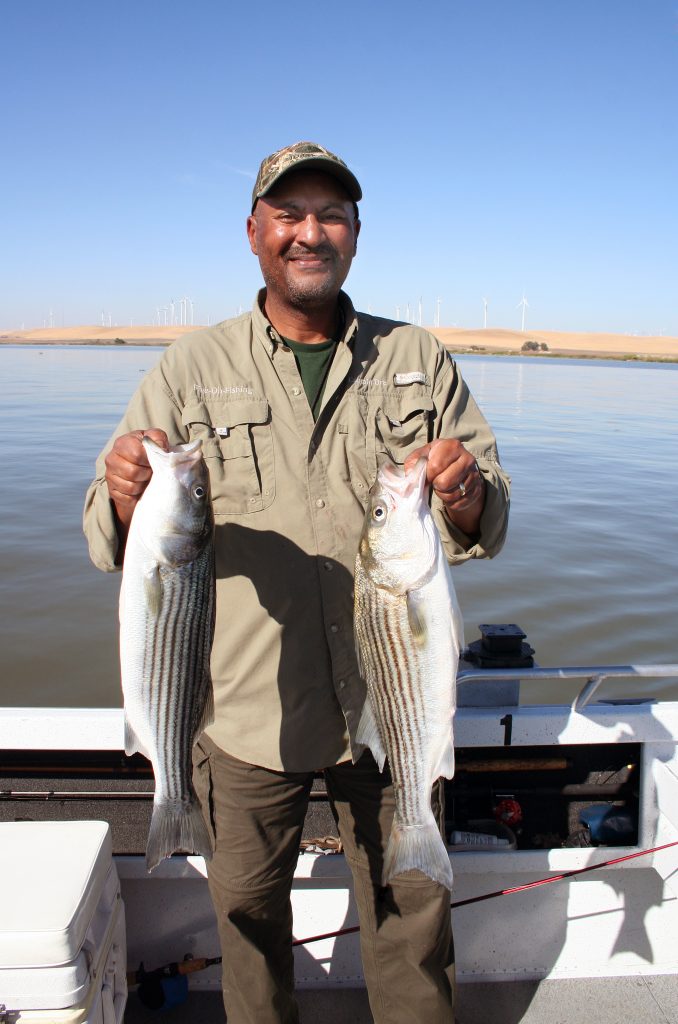Fall striper fishing on the West Delta is one of my favorite fisheries in California. In between bouts of north wind, calm reigns over the waters, and we get to experience the delta at its finest.
On October 8, I planned a trip to the West Delta with Andre Fontenot of San Bruno. Andre and I have mutual friends, but we have never been able to connect for a fishing trip until now. Andre was curious about my method for catching striped bass, so I told him we would be using circle hooks.

After launching the boat and trolling for a short period of time, we anchored in 24 feet of water on the Sacramento River between Sherman Island and Pittsburg. We got our lines out and immediately started getting bites from sub-legal stripers. The next bite on my rod seemed out of place compared to the taps we had been experiencing.
My rod tip slowly dipped down about six inches and stayed loaded up. The rod tip continued to bob up and down a few inches at a time, never letting up. “Big fish” I said in a whisper tone.
Andre was probably thinking I was nuts, because the rod wasn’t pegged to the water. In my experience, I’ve learned that the smooth, constant bites are usually the bigger fish. As the rod continued to dip, I started reeling at a moderate pace with the rod still in the holder. The rod loaded up, and I said, “Fish on!”
The pressure let up, and I thought I lost the fish for a moment, but then I felt the pressure again and pulled the rod out of the holder. “It’s a keeper, get the net”, I relayed to Andre. The fish made its way to the port side of the boat, and then made a blistering run way out to the side. “I bet it’s a sturgeon”, I said as the fish continued to peel line off the reel.
Andre cleared the other rods, and the fish crossed over to the starboard side of the boat. At this point, the fish made an unstoppable run downstream. In all of my years fishing, I’ve never been worried about being spooled until that very moment. The fish had the reel down to my braided backing line, and it was continuing to run downstream. There wasn’t much I could do to stop it.
Before I go any further, let me explain the rig I’ve developed for bait fishing for striped bass. I start with a reel spooled with 25 pound test monofilament line. I’m using at least 9 foot long parabolic fiberglass noodle rods. This means they bend all the way down to the reel, looking like a letter ‘C’ when they are loaded up. I like these because it allows the fish to grab the bait and run for a few feet before the rod eventually loads up and they are hooked.
Speaking of hooks, I’m using Gamakatsu 8/0 inline octopus circle hooks with a straight eye (265418 INLINE OCTOPUS CIRCLE SE). I tie these on a 3 foot long 25 pound test monofilament leader. I tie a snell knot so the leader comes out of the eye on the same side as the hook point. This forces the hook point towards the line when you hook a fish.
To complete the rig I run a sliding sinker above the leader, and load the hook with something stripers love like shad, anchovies, sardines, pile worms, or in this case, chicken livers.
The long limber rods do their by job hooking fish, and they are easily up to the task of landing average sized striped bass. However, when really large fish are hooked on these rigs, you are dependent on your line strength and a quality drag to save the day.
I told Andre we might have to drop anchor and chase the fish downstream, but moments later I started gaining on the fish. After about ten minutes, I said, “This fish doesn’t feel very sturgeony”. It wasn’t head shaking, jumping, rubbing in the line, or using any of the normal sturgeon tactics. “It might be a big striper”, I related.

I finally had my sinker to the surface, but the turbid water made it hard so see any further than a foot deep. Each time we thought we had a chance to net it, the fish would strip about ten feet of line towards the bottom. After repeating this scene for several minutes, we finally got a glimpse of the fish.
“It’s a big striper!” I uttered in excitement. In one swoop, Andre had the fish safely in the net. Since the circle hook had the fish cleanly pinned in the side of the mouth, I wanted to release the big breeder to spawn some future stripers.
In the past, I’ve read that it’s not good for a fish’s survival to suspend a large fish from its lower jaw like we’ve all been accustomed to seeing in bass magazines.
Because of this, I attached my scale to the net and weighed the fish suspended by the cradle of the netting. The final tally was 24 pounds and 39 inches in length. After a few quick photos, I revived the fish in the water using my fish gripper. Once the pectoral fins were extended and the fish started biting, I released the gripper. The huge bass swam slowly back down into the murky waters of the west delta and out of sight.
Andre and I continued to fish until about 3 pm that afternoon in perfect weather. We ended the day with four fish in the 4 to 5 pound range for the grill, while releasing two other keepers. Days like that are what make me continue to believe that autumn fishing in the West Delta is one of my favorite places to be.
